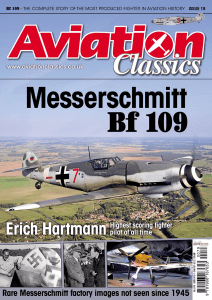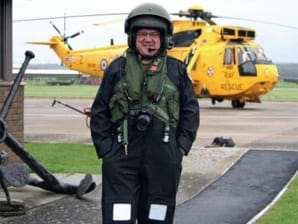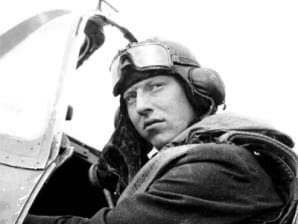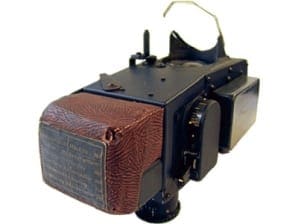 Now this one really is a problem. I have had difficulties with this page before, as anyone who reads it knows, but nothing quite like this. Not only is this aircraft an icon, an astounding piece of engineering that is matched in longevity only by the Supermarine Spitfire, it is also a symbol for the darkest empire to ever throw its shadow across the globe. As Cassadian test pilot Klaus Plaza and photographer Constance Redgrave so simply and eloquently put it, it’s the bad guy.
Now this one really is a problem. I have had difficulties with this page before, as anyone who reads it knows, but nothing quite like this. Not only is this aircraft an icon, an astounding piece of engineering that is matched in longevity only by the Supermarine Spitfire, it is also a symbol for the darkest empire to ever throw its shadow across the globe. As Cassadian test pilot Klaus Plaza and photographer Constance Redgrave so simply and eloquently put it, it’s the bad guy.
How to celebrate a work of genius when it is so tarnished by association? That’s the difficulty here. I have been pondering this piece for some time, having talked to many people who flew and maintained this aircraft during my life, all of whom are now dead, I felt that I owed it to the memory of some astounding friends to do these men and their aircraft justice. Two things happened that opened my eyes as to how this could be achieved, the first was that former RAF fighter pilot Squadron Leader Clive Rowley sent in his piece on the remarkable Luftwaffe fighter pilot Erich Hartmann. The second was I overheard a conversation in Berlin.
At the end of his piece, Clive quotes Hartmann directly, who was recorded as saying: “One thing I learned is this: never allow yourself to hate a people because of the actions of a few. Hatred and bigotry destroyed my nation, and millions died. I would hope that most people did not hate Germans because of the Nazis… never hate, it only eats you alive.” A remarkable sentiment from a remarkable man, and one which brooks no argument. The second event was while I was leaning on the fence of the static park at the ILA, the Berlin Air Show. I was admiring the superbly maintained Bf 109 which was part of the flying programme, watching the thousands of visitors bypass the modern and powerful jets and make a beeline for the shark in the park.
That’s what it looked like, even in the company of the modern combat aircraft, there was something undeniably dangerous in its lithe and elegant form. It formed the centrepiece of the show, of that there is no doubt. An older lady in company with her husband stopped for a long time next to me by the fence, her eyes never leaving the hive of activity around the 109. She turned to her husband and said simply: “How can something so beautiful make me so ashamed and so proud?”
They stayed by the fence not speaking until long after I had left. I do not know who they were, but I do thank her for her illumination. For too long the association with National Socialism has been allowed to taint the memory of a remarkable engineering achievement and a group of brave and dedicated servicemen. In allowing that, we give the evil represented by the Nazis far too much power. I would like to think we have moved on from this and can now acknowledge that a brave man is exactly that, regardless of the insignia on his aircraft or uniform.
The grace, yet sheer force, of a Bf 109 display today should be a fitting memorial to the pilots and engineers who flew and maintained them. While the Nazi regime the Bf 109 was originally built to serve is the most reprehensible in history by any standards, the crews who operated the Bf 109 cannot be measured alongside it. Pilots, in fact aviators the world over, mostly had little time for politics, they are drawn into the service by their love of flying, proud to serve their country and brave in that service. If I may wax poetic a moment, I think W B Yeats said it best: Nor law, nor duty bade me fight, Nor public men, nor cheering crowds, A lonely impulse of delight Drove to this tumult in the clouds; That is what I hope I have captured in this magazine, a combination of the genius behind the aircraft and the dedication of those that flew it, free of the shadow of the past.
 As ever, I have been assisted in this end by a great many talented and knowledgeable people, but I would particularly like to thank three great fighter pilots, all now turned writers. Colonel Douglas C Dildy of the USAF, Squadron Leader Clive Rowley, former commander of the Battle of Britain Memorial Flight, and Cassadian Test Pilot Klaus Plaza. An American, an Englishman and a German, all working together to record history accurately and fairly. Now that’s a world I can live in with pride.
As ever, I have been assisted in this end by a great many talented and knowledgeable people, but I would particularly like to thank three great fighter pilots, all now turned writers. Colonel Douglas C Dildy of the USAF, Squadron Leader Clive Rowley, former commander of the Battle of Britain Memorial Flight, and Cassadian Test Pilot Klaus Plaza. An American, an Englishman and a German, all working together to record history accurately and fairly. Now that’s a world I can live in with pride.
All best,
Tim
 Contents
Contents
8 Willy Messerschmitt
22 Genesis of a legend – 109 design and development
28 Into service and into battle – The 109A to D
34 The 109s in combat
38 Firepower and performance – The 109E
40 Production – The key to success
48 Lithe and light – The 109F
52 Gustav – Too much of a good thing
56 Kurfurst – Production priorities
58 Erich Hartmann
74 ‘Toni’ – The carrier 109
92 Dead ends and desperate designs
98 Inside the 109
106 Czech Mules and Spanish Pigeons
118 The 109 abroad
126 Survivors
The 109 in combat: The story from the other side…
 I have had a half-century-long interest in bravery in general, and gallantry medals in particular. I collect decorations awarded to British, Commonwealth and occasionally other Allied servicemen. Yet, as I write in my new book Heroes of the Skies, for me the concept of bravery is not, and never will be, limited to just one side in a battle or conflict.
I have had a half-century-long interest in bravery in general, and gallantry medals in particular. I collect decorations awarded to British, Commonwealth and occasionally other Allied servicemen. Yet, as I write in my new book Heroes of the Skies, for me the concept of bravery is not, and never will be, limited to just one side in a battle or conflict.
German pilots, including those flying the famous Messerschmitt Bf 109s faced similar trials and tribulations in the air to their British and Allied counterparts, and repeatedly showed outstanding courage in combat. However, my new book tells the stories of those men who flew against the Bf 109 pilots. Here are two excerpts from Heroes of the Skies…
Pilot Officer (later Flight Lieutenant) George Gribble DFC George Gribble served with 54 Squadron and, as a pilot officer, flew Spitfires during the Battle of Britain when he was in constant combat with Bf 109s.
On May 24, 1940, Gribble and his squadron were involved in a heavy combat with the Luftwaffe over the Dunkirk-Calais sector. Gribble destroyed a Bf 109 after firing 1700 rounds from a range of 250 yards. He later recalled: “I saw my tracer crossing into his aircraft while he was on his back. He just fell into the ground…” However, Gribble’s Spitfire was badly damaged the following day when his squadron was jumped by about a dozen Bf 109s. Gribble carried out a forced landing on a beach near Dunkirk where he removed his radio equipment from the cockpit before finding passage home on a steamer bound for Dover.
Gribble’s DFC was announced on August 13, 1940, when his citation stated: “Pilot Officer Gribble has led his section, and recently his flight, in a courageous and determined manner… this officer has personally destroyed three Messerschmitt 109s, and damaged many others.”
On August 16, Gribble damaged a Bf 109 east of RAF Hornchurch, Essex. “I managed to get in a long burst (10 seconds), opening at 300 yards and closing to 200 yards range. Smoke began to pour out of the machine and it went into a dive,” he wrote. Two days later Gribble acted as blue leader in ‘B’ Flight, and destroyed another Bf 109.
By early November 1940, Gribble’s confirmed score stood at six and one shared enemy aircraft destroyed. However, while on a bomber escort sortie on June 4, 1941, Gribble was seen leading his section against two Bf 109s when his Spitfire was suddenly ‘bounced’ by further enemy fighters.
Gribble was heard to say over his radio: “Engine cut, baling out.” A fellow pilot saw his parachute going down into the sea, some 12 miles off the English coast. Boats quickly reached the spot where Gribble hit the water but the pilot could not be found and he was presumed dead, just two weeks before his 22nd birthday.
In a letter to Gribble’s mother dated June 9, the squadron’s CO wrote: “George was an exceptional pilot and leader and also a very keen officer. He was also very entertaining in the mess and most loved by all of us. The whole squadron will miss a very gallant and brave gentleman for a very long time to come…”
Sergeant (later Squadron Leader) James Lacey DFM and Bar James ‘Ginger’ Lacey was quite simply one of the greatest fighter aces of the Second World War, including being the second highest scoring British fighter pilot of the Battle of Britain. By the end of the war, he was credited with 28 enemy aircraft destroyed, five ‘probables’ and nine damaged. Many of Lacey’s most memorable dogfights during the Battle of Britain were with pilots of Bf 109s.
While based in Le Mans and serving as a sergeant with 501 (County of Gloucester) Squadron, Lacey had a close call after a combat with a Bf 109 over Le Mans on June 9, 1940, when, after a forced landing, his aircraft was thrown on to its back. As blood streamed down his face from a cut, water and petrol fumes filled the cockpit. Lacey managed to kick out the Perspex canopy. However, overwhelmed by fumes he passed out, still in the cockpit, but he was saved by French peasants who cut him free and took him for medical treatment.
However, he enjoyed better luck on July 20, 1940, when his squadron was scrambled and ordered to defend a convoy off Jersey. After flying out over Portland Bill, they saw a horde of Junkers Ju 87 bombers, with Messerschmitt escorts, and went into battle. After Lacey spotted a Bf 109 turn towards him, he broke hard and, after several decreasing inward turns, put a burst into the fuselage. He then followed the stricken aircraft down to finish it off.
Next he successfully engaged a Bf 109 which was crossing his path at 90º. As Lacey turned for a second attack, he saw that Flying Officer ‘Pan’ Cox was on the enemy’s tail, finishing it off. Lacey put in no claim for the second ‘kill’ allowing his comrade his first victory.
Lacey was awarded the DFM in August 1940 and a bar to his decoration in November of the same year. He survived the war and, after becoming a flying instructor, he was appointed in 1968 as a technical adviser on the film, Battle of Britain. Lacey died on May 30, 1989, aged 72.
Heroes of the Skies by Michael Ashcroft
The book is published in hardback by Headline and costs £20 (RRP). It is available now from all good bookshops or online at Amazon. All author’s royalties are being donated to the RAF Benevolent Fund, the custodian of the new Bomber Command Memorial.
The book is published in conjunction with a six part Channel 5 documentary series. The author is a Conservative peer, international businessman and philanthropist.
 Production priorities
Production priorities
 The last production development of the Bf 109 proved to be the fastest, capable of 440mph (710kph). However, production was to be delayed by the Allied bombing campaign meaning that the Bf 109K was almost too little, too late.
The last production development of the Bf 109 proved to be the fastest, capable of 440mph (710kph). However, production was to be delayed by the Allied bombing campaign meaning that the Bf 109K was almost too little, too late.
As the tide of the war turned against Germany in 1943, the RLM became concerned with the plethora of types and sub types of the Bf 109 then in service. The maintenance situation was complicated, even getting the right spares could be difficult as there were so many possible combinations of airframe, engine and armament even within a single unit. Walter Göttel, who at the time was in charge of organising the licence production contracts for the Bf 109, estimated that over 1000 detail changes had been incorporated into the fighter since it entered service, and the situation was becoming both costly and critical.
The RLM advised Messerschmitt that the design and production of the fighter was to be rationalised. A new version of the aircraft was to be produced with fewer variants and more commonality of spares and equipment. At the same time, the problems still evident in the aircraft were to be dealt with. Messerschmitt handed the consolidation programme to Ludwig Bölkow in late 1942, who at the time was one of the Augsburg project team. A consolidation team of 140 designers, stress analysts, draughtsmen and engineers was assembled at the Weiner Neustädter Flugzuegwerke (WNF) in Austria who began work early in 1943. By August, the plans and design drawings for the new model, known as the Bf 109K or Kürfurst, were almost complete. On August 13, 1943, the WNF was heavily bombed, and some of the work was lost, as were some of the development team. The project was moved to the Messerschmitt plant at Regensburg, which caused delays, exacerbated by development problems with the Daimler-Benz DB 605D engine. However, the new design was finally completed in the middle of 1944 with deliveries beginning in October.
While the new fighter was to be produced at Regensburg, initially the WNF and Messerschmitt Augsburg factories were to continue producing the last models of the Bf 109G to avoid to much disruption in the supply of new fighters at this critical time. Since none of the proposed models of the Bf 109K were fitted with pressurised cockpits to keep production simple, all of the model designations were given even numbers.
The RLM reviewed the plans, and decided that the first model, the Bf 109K-2, was simply too similar to the Bf 109G-10 to allow the disruption it would cause for no real benefit. Production of the K-4 was approved, and by March 1945, 1593 had been delivered to the Luftwaffe.
Figures for the production after this were lost as the war ended. This was the fastest Bf 109 of the Second World War, with a maximum speed of 440mph (710kph). New propellers were being developed for the aircraft which would have boosted this impressive figure still further, but the war ended before they could be tested. The first aircraft off the production line were powered by the 1800hp DB 605DM, but this was only intended as a development version of the engine. After the first few aircraft, it was quickly replaced by the DB 605DB and DC production versions which could produce 2000hp with the MW 50 water methanol boost system. Every Bf 109K produced was fitted with the MW 50 as standard.
The armament was also standardised, as ammunition supplies to the front line units was another of the logistics problems the RLM wished to solve. The 30mm MK 108 motorkanone was fitted firing through the engine and a pair of MG 131 13mm heavy machine guns were mounted in the upper cowling. Having said that, it is known that a number of Bf 109K-4s were fitted with the 20mm MG 151/20 motorkanone, as the MK 108 was prone to jamming. This problem also caused the addition of a pair of Mauser 20mm MG 151/20 cannon in underwing pods as one of the Rüstsatz (R) kits for field use to ensure the K’s potency as a bomber interceptor.
With the Bf 109K-4 in full production at Regensburg, a number of other variants were proposed that would eventually replace all of the Bf 109G aircraft then in service. A few of the K-6 version were produced with an additional pair of wing mounted MK 108 cannon, but these proved to have such a deleterious effect on the performance of the aircraft that they were removed from the few built. None of the pilots flying the Bf 109 liked the wing mounted cannons on the later versions of the fighter as they had a dramatic effect on the roll rate of the aircraft, dramatically reducing the fighter’s manoeuvrability. Given that they were now encountering the latest Allied fighters such as the Yak 9D, P-51D Mustang and Hawker Tempest, they needed all the manoeuvrability they could get.
The Bf 109K played a major part in the last large scale Luftwaffe operation of the Second World War, Operation Bodenplatte. This was an attack in the early hours of January 1, 1945, by every fighter that could be mustered, 1035 in total, against the Allied airfields in Northern France, Belgium and the Netherlands. Although some damage was done to the Allied tactical air forces, greater harm was done to the Luftwaffe’s fighter units, who lost many experienced leaders in the operation. This was to be the swan song of the Bf 109, as in the remaining 17 weeks of the war, fighter units were becoming increasingly short of ammunition, fuel and pilots. In the last year of the war, despite the bombing campaign aimed at the aircraft industry, German aircraft production actually doubled, so aircraft were never the problem. Finding fuel and experienced men to fly them was.
As the Allies advanced and the airfields and then the factories were overrun, the dwindling numbers of fighters and pilots fought an increasingly desperate and hopeless battle. The last Bf 109Ks were on a par with the latest Allied fighters, in fact the Bf 109 had the best climb rate of any fighter of the conflict, but the many novice pilots then in the Luftwaffe were unable to match their opponents in either experience or numbers. Many Bf 109s were burnt on their airfields to prevent their capture, but many fell into the hands of the Allies. On May 8, 1945, the agony was over, but the legend of the Bf 109 was to continue in some very surprising theatres, as will be described later in this magazine.



